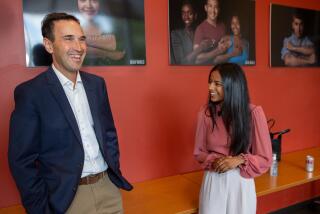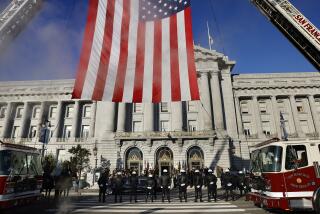Gorbachev Tour Ends in Passage to New Era : Diplomacy: The Soviet leader expects a long period of peace. He meets with the Reagans on Bay Area visit.
- Share via
SAN FRANCISCO — Soviet President Mikhail S. Gorbachev finished his seven-day North American tour Monday with a symbolic passage from old to new, lauding past progress in Soviet-American relations with Ronald Reagan, then opening a new era in East Asia by meeting with South Korean President Roh Tae Woo.
Greeted by warm sunshine, lavish praise and much of the political and business elite of the West Coast, Gorbachev toured San Francisco and visited the Stanford University campus at Palo Alto.
“The Cold War is now behind us,” he told Stanford students and faculty members in a speech interrupted frequently by applause.
“I think and hope we’re entering a long period of peace,” he added in an address to business and political leaders at a late-afternoon luncheon back in San Francisco.
Hitting several themes that he has reiterated throughout his American trip and in other appearances in recent months, Gorbachev called for scientists and intellectuals from both superpowers to work together to move their economies away from defense production.
“The military economy is ultimately a dead end,” he said.
And he urged a “new approach to the structure of security and cooperation and even alliance building,” repeating his proposal that the North Atlantic Treaty Organization and the Warsaw Pact be replaced by a new joint security structure.
Gorbachev has called for greater emphasis on the Council on Security and Cooperation in Europe, which includes all members of both alliances. Bush Administration officials have said they favor an expanded role for the CSCE but insist that NATO must remain the principal guarantor of security in Europe.
“For a long time, the Pacific was a theater of confrontations and the arms race,” Gorbachev added. “Located on opposite shores, our two nations have found themselves on the opposite sides of the barricades of Asian revolutions.”
Now, “to avoid finding ourselves on the sidelines in the Pacific,” he said, “we ought to think about the speediest way to abolish political, military rivalry.”
In a speech following Gorbachev’s, former Secretary of State George P. Shultz told the Soviet leader: “You light up the landscape with your ideas. You are a great leader. You have a key part to play in this drama--we need you.”
Later, introducing Gorbachev to the luncheon for many of the leading business and political figures of the West Coast, Gov. George Deukmejian said he had been musing about what might have happened had his ancestors stayed in Russian Armenia and Gorbachev’s settled in the 19th-Century Russian colony in California.
“Our positions might have been reversed,” Deukmejian said. “I’m sure you would have been elected as governor of California.”
At the end of the day, Gorbachev met with Roh, a meeting that could mark the end of an era of tension that began with the division of the Korean Peninsula after World War II and which cost hundreds of thousands of lives during the Korean War.
After a day of cold rain Sunday in Minneapolis, Gorbachev toured the Bay Area under brilliant blue skies and bright sun. But as in the Midwest, Bay Area residents greeted the Soviet leader with enthusiastic crowds of both protesters and well-wishers.
Gorbachev began his public day by seeing Reagan and his wife, Nancy, at the home of the Soviet consul general in the city’s Pacific Heights section. The meeting took place nearly an hour late; Gorbachev told American officials that he was tired and needed to rest.
After shaking hands with the Reagans, he and his wife Raisa joked about jet lag.
“All the time zones are mixed up,” he said, “It’s sort of upside-down.”
The two couples posed on a balcony overlooking the Golden Gate Bridge for photographs before retiring inside for a 25-minute reunion, during which Gorbachev presented Reagan with a medallion thanking him for sending help to Soviet Armenia after a devastating earthquake there in 1988.
“That’s one thing we have in common,” Reagan told Gorbachev. “We’re both threatened by earthquakes now and then.”
“We both are together in trying to increase the closeness of our two countries,” Reagan told reporters after the meeting, declining to discuss the specifics of what Gorbachev said.
“If anyone should be praised for what has taken place, I think it should be the two of us,” he added. “We have continued ever since that first meeting (in November, 1985) to try to eliminate obstacles between us, and we’ve been pretty successful.”
Nancy Reagan proclaimed the meeting “very nice,” denying the existence of friction between herself and Raisa Gorbachev, something Mrs. Reagan had written about herself in her memoirs last year.
“I think there’s been a great misunderstanding about our relationship,” she said.
At Stanford, where Gorbachev arrived by motorcade shortly before noon, the yellow, green and red of the Lithuanian flag waved by Baltic-American demonstrators mingled with such signs of approval as one held up by a group of Stanford students proclaiming: “Gorbachev 4 President.”
As an official delegation led by university President Donald Kennedy and his wife, Robin, and Shultz and his wife greeted Gorbachev, about 200 demonstrators chanted “ Nyet, Nyet Soviet” and an airplane circled trailing a banner proclaiming “Gorby--Free the Baltic States.”
The intruding plane, eyed warily by security agents carrying binoculars, was quickly shooed away by a pair of helicopters.
Gorbachev bantered lightly with the greeters, asking one student, “I have one question: Is Stanford going to beat Cal this year?”
Shultz presented Gorbachev with a Russian revolutionary poster from the Hoover Institution’s extensive archives. It was only one of several gifts that the Soviet leader received during the day.
San Francisco Mayor Art Agnos presented Gorbachev with two Apple Macintosh computers, a key to the city’s historic Mission Dolores and a bronze statue of St. Francis that had been given to the city by an anonymous donor who asked that it be passed on to the Gorbachevs.
After concluding his visit to Stanford, Gorbachev took the 25-minute drive back to San Francisco, where a children’s chorus serenaded him as he entered the ornate lobby of the downtown Fairmount Hotel for the lunch with business leaders.
The lunch was similar to meetings that Gorbachev has held on nearly all his overseas trips. Each has been designed as a high-level sales pitch, with Gorbachev urging the leading figures of world capitalism to invest money in his efforts to rebuild the moldering Soviet economy.
Among those holding the coveted seats for the luncheon were many prominent leaders of the region’s high-technology, banking, communications, oil and gas and construction companies, a virtual catalogue of the sorts of investment that Gorbachev believes his nation needs.
Apple Computer Inc., which is advising the Soviet educational system on the construction of research laboratories and has provided a small number of Macintosh computers to the Soviet Academy of Science, was represented by its chairman, John Sculley. The company’s co-founder, Steve Wozniak, who has worked for nearly a decade on providing high-tech links with the Soviet Union, was present, as were Hewlett-Packard Co. co-founders David Packard and William R. Hewlett, whose company last year sold $30 million worth of medical and testing equipment to the Soviets.
Also present were representatives of Chevron, which over the weekend signed a joint venture agreement to explore a potentially massive oil field in Soviet Central Asia, and Bechtel Group Inc., which has consulted with the Soviets on a range of projects from steel to construction.
Gorbachev urged his listeners to help develop the vast resources of Siberia.
“We want to enhance the potential of the Soviet Far East,” he said. “An external economic component”--Soviet jargon for outside investment--”will be of great value.
“For 72 years of our history we’ve had many clear models,” he said. “The thing now is to give people a free hand . . . . The way forward, the path, is difficult, but it is interesting.”
His trip completed, Gorbachev flew out of San Francisco at 7:45 p.m., beginning what officials said would be about a 13 hour flight back to Moscow with a refueling stop in Gander, Newfoundland.
The following Times staff writers also contributed to coverage of Gorbachev’s visit to the Bay Area: In San Franciso: Martha Groves, Norma Kaufman, Dan Morain, Michael Parks and George Ramos; at Stanford: Anthony Day, Larry Gordon, Philip Hager, Jim Herron Zamora and Victor Zonana; and in Los Angeles: Kevin Roderick, Shari Roan and Tracy Thomas.
A QUICK CHAT--Gov. George Deukmejian gets only a few minutes with President Mikhail S. Gorbachev to argue for better treatment for Armenians. A8
A TOURING FIRST LADY--Raisa Gorbachev meets Nancy Reagan, then leads police and fans on a mad whirl through city by the bay. A9
THE GERMAN QUESTION--Reunification of Germany is likely to be a slow process, despite the glow left by President Bush’s talks with Gorbachev. A10
LITHUANIA LECTURE--Senate Majority Leader George Mitchell charges that Bush has “abandoned Lithuania” by reaching a new trade agreement with Moscow. A10
THE GORBACHEVS IN THE BAY AREA
1. Mikhail and Raisa Gorbachev breakfast with former President Ronald Reagan and Nancy Reagan at home of Soviet consul general in San Francisco’s Pacific Heights.
2. Gorbachevs visit Stanford UNiversity in Palo Alto. They meet with university President Donald Kennedy and his wife and former Secretary of State George P. Shultz and his wife. They also tour Stanford Art Museum and visit Stanford School of Business.
Gorbachev delivers speech to students and professors at Stanford’s Memorial Auditorium.
3. Gorbachev return to San Francisco for lunch and speech to area business leaders at Fairmont Hotel.
4. Raisa Gorbachev tours San Francisco sites, including Golden Gate Park, War Memorial Opera House, Davies Symphony Hall, and Fisherman’s Wharf.
Gorbachevs meet with South Korean President Roh Tae Woo at Soviet consul general’s residence.
5. Gorbachevs visit F. Point for view of Golden Gate Bridge before departing for San Francisco International Airport.
6. Gorbachevs depart San Francisco for Soviet Union.
More to Read
Sign up for Essential California
The most important California stories and recommendations in your inbox every morning.
You may occasionally receive promotional content from the Los Angeles Times.














